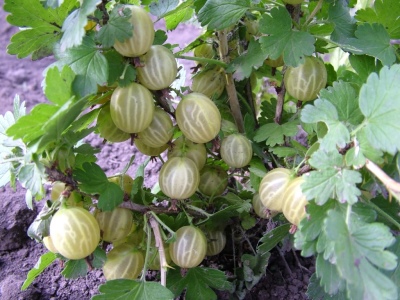
- Authors: Belarusian Research Institute of Potato and Horticulture
- Appeared when crossing: free pollination of Columbus seeds
- Name synonyms: Yarovoyi
- Growth type: medium-sized
- Description of the bush: medium spreading
- Escapes: few, straight
- Thorniness: medium
- Thorns: thin, double, less often - single
- Sheet: shiny, dark green with rounded, serrated edges
- Berry size: average
Gooseberry is a berry shrub grown in almost every country house. Popularity is due to the nutritional value and healing properties of berries. For beginner summer residents, the early-ripening gooseberry variety of the Spring Belarusian selection will be ideal for growing.
Breeding history
Gooseberry Yarovaya is the result of the fruitful work of breeders of the Belarusian Research Institute of Potato and Horticulture. To breed the early species, a free pollination method was used using the Columbus gooseberry variety. Recommended for growing in the temperate zone of Russia.
Description of the variety
The Belarusian gooseberry is a medium-sized shrub that reaches a height of 100-150 cm. It is characterized by an erect bush with a slight spreading of branches, an average thickening of the crown with dark green leaves with a glossy coating and moderate thorniness. Sharp double spines are evenly spaced along the entire length of the shoot. During the flowering period, the shrubs are covered with pale flowers with a weak aroma. Spring gooseberry is one of the most transportable crops with good keeping quality. In a cool place, the harvested berries can be stored for up to 5 days.
Gooseberries of Belarusian selection are self-fertile varieties, therefore they do not need donor bushes. Fruits are tied by pollinating their own flowers with pollen. In practice, planted pollinating shrubs can increase yields by a third.
Characteristics of berries
Gooseberries are medium-sized. The average weight of the berry is 3.5 g. The shape of the fruit is oblong or rounded-oblong with a smooth surface without edges. Ripe gooseberries have an interesting color - lemon yellow. At the stage of technical maturity, the berries are covered with a greenish color. The peel of the berries is thin, with a slight sheen and pronounced light streaks.
Taste qualities
The variety has good taste and commercial qualities. The pulp is endowed with a tender, fleshy and not very dense texture with high juiciness. The berries have a harmonious taste - sweet and sour, very refreshing, complemented by a fruity aroma. The pulp contains a huge amount of vitamin C (up to 42%).
Ripening and fruiting
Spring represents a class of early ripening berry crops. The shrub begins to bear fruit at 3-4 years of age. The maximum crop yield is observed in the 6-7th year of growth. Under favorable conditions, the plant can produce crops for 17-20 years. The first berries can be tasted at the end of June, and the peak of fruiting occurs at the beginning of July.
Yield
The yield indicators for the variety are average. Subject to all the conditions of growing and care, the bush will certainly thank you with a good harvest. On average, 3.4 kg of gooseberries can be obtained during the fruiting season. Gooseberries spice up amicably and quickly, so you shouldn't overexpose the berries on the bushes, as they can be baked under the scorching sun.
Growing regions
Berry crops are massively grown in the North-West, Central Black Earth, Volga and Volga-Vyatka regions.
Landing
You can plant gooseberries in spring and autumn.If planting is carried out in spring, then March-April is considered the best period, the main thing is to have time to plant before the beginning of the growing season. Autumn planting is October, a month before the onset of the first frost. According to experienced farmers, it is the autumn planting of seedlings that is considered the best. The ideal planting material is a two-year-old seedling with 2-3 shoots 25-30 cm long and a developed rhizome.

Growing and care
It is recommended to grow shrubs on a site with the following characteristics: good sunlight, reliable protection from gusty winds and drafts, deep passage of groundwater, neutral soil acidity, characterized by excellent fertility and air permeability.
The culture can be propagated by different methods - vertical and horizontal layering, green and lignified cuttings, dividing the bush. Reproduction by green cuttings is considered optimal.
Agricultural technology of the variety includes: watering, fertilizing, sanitary pruning of branches and thinning of shrubs, loosening of the soil, measures to protect against rodents, viruses and insects. Preparing for winter involves mulching the near-root zone.



Disease and pest resistance
The immune system of the variety is average. Gooseberry is resistant to American powdery mildew, but is subject to a number of other diseases - septoria and anthracnose. Among the pests that attack gooseberry shrubs, it is worth highlighting such as aphids, common spider mites, yellow sawfly, glass and gooseberry moth.

In order for the gooseberry to produce a good harvest, it is necessary to devote time to disease prevention.
Resistance to adverse climatic conditions
The culture has a high level of frost resistance, and it also easily survives prolonged drought, withstands long-term transportation. The culture reacts negatively to excess moisture, direct scorching sun during fruiting and drafts.




































































